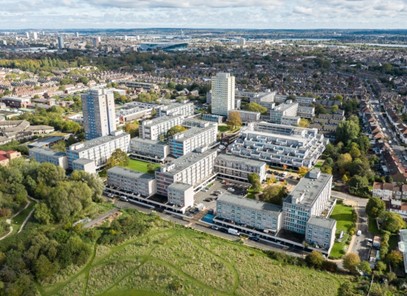Collaborative Planning
Area: Design, planning and building
State-controlled spatial planning has been criticised for being too paternalistic as it tends to exercise political weight from the top, indicating the imbalance of power in decision-making processes (Albrechts, 2003). Furthermore, the dominance of an urban (economic) growth ideology in planning is discussed in critiques which address the problems of trust and accountability in central planning authorities. While the state is expected to act in the public interest through the rational and impartial guidance of planners, there is a notable lack of trust observed towards planning institutions and their methods of operation (Swain & Tait, 2007).
A common issue raised in the critiques of planning institutions is how the prioritisation of the technical knowledge of “expert” professionals is leading to the exclusion of the public through the resulting lack of diversity in universal assumptions of their interest, the lack of transparency and the changing political dimensions of planning decisions in general. In addition, the advancement of neoliberal ideology, either by rolling back the power of the state, or by the state operating as an entrepreneurial actor, has led to further mistrust of planning mechanisms aligned with urban entrepreneurialism (Phelps & Miao, 2020). State-market partnership dominance allows very little room for citizens that are not in positions of power to influence planning decisions and develops mistrust towards hegemonic planning institutions. A major dilemma is how to prioritise actions which would meet the needs of smaller groups of stakeholders while also serve the wider society. In addition, a common difficulty is the translation of theoretical concepts into practical actions that can address complex societal problems and create positive outcomes for communities and the environment.
In response to the structural failures of strategic planning and the distancing of citizens from democratic decision-making processes, Healey (1997) wrote about “practicing planning” or, “doing planning work”, focusing on the place-based, fine-grain interactions that are socially embedded and potentially able to influence the structures and power relations of existing planning institutions. The theory of collaborative planning (Healey, 1997) has been influential in the advocacy for new relations between state and local actors where policies and resources had not been previously allocated sufficiently. Collaborative planning accepts the highly political nature of allocating resources such as housing and social infrastructure, and aims to eradicate socio-economic injustices in certain areas. Collaborative planning ensures citizens’ right to be heard and the accountability of decisions made after the planning process by those in power. However, collaboration in planning has largely involved the management and mediation of continuous conflicts, for example, between competing urban interests.
Moreover, scholars of collaborative planning theory use the paradigm of communicative planning to argue that “communication itself is a form of action that changes the realities of the social world, including power relations” (Innes & Booher, 2015, p. 200). Communicative planning as an overarching paradigm is a fundamental means for instilling ethics and justice judgements in the particularities of collaborative planning theory which is specific to place (Campbell & Marshall, 2006; Innes & Booher, 1999). Innes and Booher (2003) discuss the capacity of society to govern and claim that the building of collaborative capacity for governance is dependent on “mutual trust and shared understandings” (Innes & Booher, 2003). However, while the paradigm of communicative planning stresses the need for a more equitable distribution of power (Albrechts, 1991, 2003; Forester, 1999), the operationalisation of communicative planning theory into action has remained a great challenge. Feelings of unfairness translated also into a lack of trust in public administration and other context-dependent challenges related to the governing processes are often found to be major obstacles in citizen-government collaboration.
Both collaborative governance and planning emphasize collaboration and stakeholder engagement but one needs to precede the other. Firstly, collaborative governance involves the rules and forms of interaction and communication through which public and private actors work collectively during decision-making practices (Ansell & Gash, 2008). Secondly, collaborative planning is a theory related to plan-making and policy-making in terms of spatial development and the management of public resources which depends on the consensus-building capacity of collaborative governance practices. Through the integration of collaborative approaches in governance and planning at the local level, alternative scales of urban governance appear, namely at the level of community, as “territorially-focused collective action” (Healey, 2006, p. 305) and by advancing bottom-up, self-organized initiatives in contrast to the top-down, modernist model that has dominated most configurations of Western urban space.
Fundamental to these considerations is the concept of placemaking in planning, explained by Healey (1998) as the work that involves people with a “stake” in a place which then makes them become active participants in urban planning processes. Hence, placemaking is the process of utilising the joint knowledge, abilities and effort of community members in collaborative planning, often involving public spaces and neighbourhood amenities, considering the balance of social and economic values and uses of land that grow out of the diverse concerns of those with legitimate interests. In other words, the communicative capacity of a community connected to a place, according to social values embodied in place, builds the capacity for direct forms of planning through discussions and plan-making process which involve all relevant stakeholders (Albrechts, 2013).
As a result, the processes of coordinating and determining the diversity of decisions, collaborative planning strategies are not confined to technical expertise. They are strategies which recognise the value of “deliberative democracy” and citizens’ involvement in policy-making. However, a more collaborative and neighbourhood-oriented approach to planning also demands the ability to respond to the conflicts, debates and micropolitics of planning practice during the cooperation between state and non-state actors. Additionally, problems of participant selection and representation, stakeholders’ ongoing commitment and the level of shared decision-making and risk-taking that local administrations are able to manage can be especially challenging (Bartoletti & Faccioli, 2016).
A deeper understanding of the contextual, variegated planning processes and how they hinder or facilitate collaborative practices at the level of everyday decisions is still overdue (Calderon & Westin, 2021). The dominance of technocratic and political actors accustomed to top-down/hierarchical norms followed by the exclusion of residents and other less-powerful stakeholders are structures which have been socially embedded and reproduced over time. Consequently, the interplay between institutions and the agency of all of the actors and their understanding of collaboration is highly context driven:
"[Institutions] emerge and are reproduced within the specific spatial and temporal horizons of action pursued by specific actors … this shows the key role of actors in mediating (supporting, reinforcing or diminishing) the influence of institutions, and thus context, in specific planning processes … Hence, an analysis of the influence that context has on specific planning processes cannot be performed without close attention to actors and how they use their agency to reproduce or deviate from the institutional setting in which they operate." (Calderon & Westin, 2021, pp. 16–17).
Currently, a resurgence of communicative and collaborative paradigms in planning is being witnessed, but by using the concepts of co-production and co-creation. For example, urban living labs are being used as experimental spaces where actors with different levels of power and different types of skills and knowledge are learning to work together. A recent analysis shows that mutual learning and collaboration reinforce each other, yet challenges which remain may be the time-intensive nature of collaborative planning in general and the lack of clarity about expectations, responsibilities and roles of participants (Knickel et al., 2023). These new platforms for deliberation allow us also to think about housing outside of the bounds of private property and as a fundamental part of decisions at the scale of neighbourhood planning.
References
Albrechts, L. (1991). Changing Roles and Positions of Planners. Urban Studies, 28(1), 123–137. https://doi.org/10.1080/00420989120080081
Albrechts, L. (2003). Planning and power: Towards an emancipatory planning approach. Environment and Planning C: Government and Policy, 21(6), 905–924. https://doi.org/10.1068/c29m
Albrechts, L. (2013). Reframing strategic spatial planning by using a coproduction perspective. Planning Theory, 12(1), 46–63. https://doi.org/10.1177/1473095212452722
Ansell, C., & Gash, A. (2008). Collaborative governance in theory and practice. Journal of Public Administration Research and Theory, 18(4), 543–571. https://doi.org/10.1093/jopart/mum032
Bartoletti, R., & Faccioli, F. (2016). Public Engagement, Local Policies, and Citizens’ Participation: An Italian Case Study of Civic Collaboration. Social Media and Society, 2(3). https://doi.org/10.1177/2056305116662187
Calderon, C., & Westin, M. (2021). Understanding context and its influence on collaborative planning processes: a contribution to communicative planning theory. International Planning Studies, 26(1), 14–27. https://doi.org/10.1080/13563475.2019.1674639
Campbell, H., & Marshall, R. (2006). Towards justice in planning: A reappraisal. European Planning Studies, 14(2), 239–252. https://doi.org/10.1080/09654310500418192
Forester, J. (1999). The deliberative practitioner: Encouraging participatory planning processes. MIT Press.
Healey, P. (1997). Collaborative planning: Shaping places in fragmented societies. Macmillan International Higher Education.
Healey, P. (1998). Collaborative planning in a stakeholder society. Town Planning Review, 69(1), 1–21. https://doi.org/10.3828/tpr.69.1.h651u2327m86326p
Healey, P. (2006). Transforming governance: Challenges of institutional adaptation and a new politics of space. European Planning Studies, 14(3), 299–320. https://doi.org/10.1080/09654310500420792
Innes, J. E., & Booher, D. E. (1999). Consensus Building as Role Playing and Bricolage. Journal of the American Planning Association, 65(1), 9–26.
Innes, J. E., & Booher, D. E. (2003). The Impact of Collaborative Planning on Governance Capacity. In IURD Working Paper Series.
Innes, J. E., & Booher, D. E. (2015). A turning point for planning theory? Overcoming dividing discourses. Planning Theory, 14(2), 195–213. https://doi.org/10.1177/1473095213519356
Knickel, M., Caniglia, G., Knickel, K., Šūmane, S., Maye, D., Arcuri, S., Keech, D., Tisenkopfs, T., & Brunori, G. (2023). Lost in a haze or playing to partners’ strengths? Learning to collaborate in three transdisciplinary European Living Labs. Futures, 152(May). https://doi.org/10.1016/j.futures.2023.103219
Phelps, N. A., & Miao, J. T. (2020). Varieties of urban entrepreneurialism. Dialogues in Human Geography, 10(3), 304–321. https://doi.org/10.1177/2043820619890438
Swain, C., & Tait, M. (2007). The crisis of trust and planning. Planning Theory and Practice, 8(2), 229–247. https://doi.org/10.1080/14649350701324458
Created on 06-03-2024 | Update on 23-10-2024
Related definitions
Co-creation
Area: Community participation
Created on 16-02-2022 | Update on 23-10-2024
Read more ->Collaborative Governance
Area: Community participation
Created on 26-10-2023 | Update on 23-10-2024
Read more ->Placemaking
Area: Community participation
Created on 08-11-2023 | Update on 23-10-2024
Read more ->Related cases

Broadwater Farm Urban Design Framework
Created on 26-07-2024
Related publications
No entries

